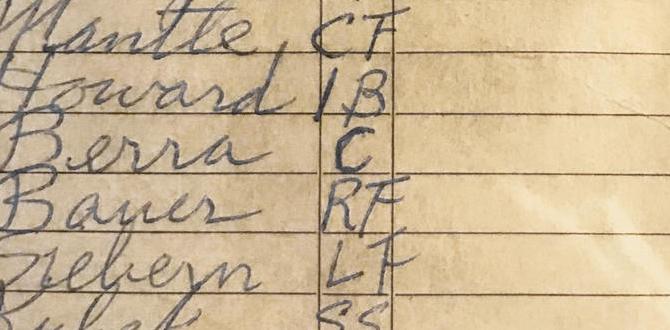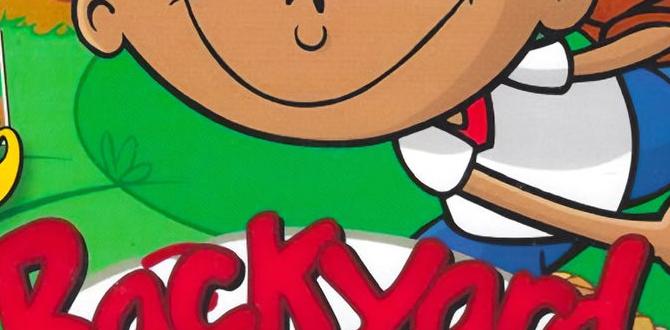Quick Summary: Mastering baseball throwing drills for beginners builds arm strength, accuracy, and confidence. This guide provides easy steps and tips for effective practice, ensuring young players develop proper mechanics and enjoy the game more, from infield throws to outfield bombs.
Baseball Throwing Drills for Beginners: Essential Tips
Are you struggling to get the ball where you want it on the baseball field? Don’t worry, almost every beginner does at some point! A strong, accurate throw is key in baseball, but learning to throw properly can feel tricky. This guide is here to help. We’ll break down the best baseball throwing drills for beginners, making it simple to build your arm, improve your aim, and feel more confident with every toss. Get ready to transform your game!
Why Good Throwing Technique Matters for Beginners
Throwing a baseball is more than just chucking it; it’s a specific skill that needs practice. When you’re just starting, focusing on the right technique from the get-go is super important. Good form helps prevent injuries, like sore elbows or shoulders. It also means your throws will be faster and more accurate, which makes playing baseball a lot more fun and successful. Learning these basics now will build a strong foundation for years of playing.
Think of it like building a house. You wouldn’t start with a weak foundation, would you? The same applies to your baseball throwing. Strong muscles, proper grip, and a smooth motion are your building blocks. This guide will walk you through how to build that solid foundation with fun and effective drills.
Essential Gear for Baseball Throwing Practice
Before we dive into drills, let’s make sure you have the right gear. You don’t need a ton of fancy equipment to start practicing your throwing. Here’s what’s most important:
- Baseball Glove: A properly fitted glove is crucial. For beginners, a slightly larger glove can help catch the ball more easily. Make sure it’s broken in so it’s soft and flexible. You can find great youth gloves designed for easy fielding.
- Baseballs: Have a few baseballs handy. Official league balls are great, but lighter, softer balls are good for younger kids or when first starting to avoid soreness.
- Comfortable Athletic Clothing: Wear clothes that allow you to move freely. Shorts or sweatpants and a t-shirt or jersey are perfect.
- Water Bottle: Staying hydrated is important, especially during practice.
While not strictly necessary for basic throwing drills, having a quality baseball bat and some catcher gear can be helpful for related practice sessions later on. For now, focus on your glove and balls!
Understanding the Basic Baseball Throwing Motion
A good baseball throw involves several key parts:
- Grip: How you hold the ball affects accuracy.
- Stance: Your body position provides stability and power.
- Windup: The motion that prepares your arm to throw.
- Arm Action: The actual movement of your arm.
- Follow-Through: Completing the motion ensures a smooth release and protects your arm.
Let’s break down each of these in our drills.
Beginner Baseball Throwing Drills: Step-by-Step
These drills are designed to be simple, effective, and fun for beginners. Start close to your throwing partner and gradually increase the distance as you get more comfortable and accurate.
Drill 1: The “Soft Toss” (Focus on Grip and Release)
This drill helps you get a feel for the ball and practice a clean release without worrying about throwing hard.
Steps:
- Find a Partner: Stand facing each other about 5-10 feet apart on a soft surface like grass.
- Grip the Ball: Place your index and middle fingers across the seams of the baseball. Your thumb should be on the underside of the ball. Your ring and pinky fingers are tucked comfortably. This is a common “four-seam” grip, which helps with control and a straight throw.
- Start with a Gentle Toss: Your partner gently tosses the ball to you. Catch it with your glove.
- Short, Easy Throw: Bring the ball to your throwing hand. With a short, controlled motion, toss the ball back to your partner. Don’t try to throw hard! Focus on a smooth release and keeping your elbow up slightly.
- Focus on Feel: Pay attention to how the ball feels coming off your fingertips. Aim for a consistent grip and a clean release.
- Increase Distance Slowly: As you both feel comfortable, take a step back and repeat.
Why it helps:
- Develops a consistent grip and release point.
- Builds arm awareness without strain.
- Improved ball control.
- Teaches a smooth, short throwing motion.
Drill 2: The “Mirror Drill” (Focus on Body Mechanics)
This drill helps you understand and feel the proper throwing motion, including your footwork and arm slot, by mimicking a partner or coach.
Steps:
- Stand Facing Your Partner: You can be on grass or even indoors if space allows. Stand about 10-15 feet apart.
- Partner Demonstrates: Have your partner (or coach) stand in a good throwing stance. They should demonstrate a proper throw to an imaginary target.
- Focus on the Steps: Pay attention to:
- Footwork: How they plant their front foot.
- Body Rotation: How they turn their hips and shoulders.
- Arm Slot: The angle of their arm as it comes forward.
- Follow-Through: Where their arm ends up after releasing the ball.
- Mimic the Motion: Without a ball, try to copy your partner’s movements exactly. Go through the windup, arm motion, and follow-through.
- Add the Ball (Softly): Once you feel comfortable with the motion, grab a ball and repeat the steps, making very gentle tosses to your partner as you practice the full motion.
- Verbal Cues: Have your partner give you simple cues like “tall and throw,” “square up,” or “finish your throw.”
Why it helps:
- Teaches correct body mechanics step-by-step.
- Reinforces proper footwork and balance.
- Helps establish a consistent arm slot.
- Builds muscle memory for the throwing motion.
- Emphasizes the importance of a full follow-through for safety.
Drill 3: “Long Toss Progression” (Focus on Arm Strength and Accuracy)
This is a classic drill that gradually builds arm strength and the ability to throw farther with accuracy.
Steps:
- Start Close: Begin about 20-30 feet apart, similar to the soft toss, focusing on good mechanics.
- Throw with Purpose: As you get comfortable, throw with a little more intent. Focus on a smooth, overhand motion, using your whole body.
- Step Back Gradually: After each successful throw or a few throws, both you and your partner take one large step back.
- Maintain Good Form: The key is to not sacrifice good mechanics for distance. If your form breaks down (e.g., dropping your elbow, rushing the throw), take a step closer.
- Increase Distance: Continue stepping back until you feel you’re at the maximum comfortable throwing distance for your current strength level.
- Work Back In: Once you reach your maximum distance, work your way back towards your partner, still focusing on accuracy and smooth throws.
Why it helps:
- Develops arm strength progressively.
- Improves throwing accuracy over longer distances.
- Teaches players to use their entire body when throwing.
- Builds confidence in making throws from various distances.
- A great warm-up and cool-down activity.
For more on building arm strength and considering baseball training equipment, check out resources from reputable sports science organizations.
Drill 4: “Target Practice” (Focus on Accuracy)
Accuracy is just as important as arm strength. This drill makes practicing your aim fun!
Steps:
- Set Up Targets: Place a few targets at varying distances. These could be:
- Cones (set up like a square or a line)
- Bucket or laundry basket
- A specific spot on a fence or wall
- Your partner holding a glove in a specific spot
- Start with an Easy Target: Begin at a distance where you can confidently hit a stationary target.
- Focus on a Smooth Throw: Use the mechanics you’ve practiced. Don’t muscle the ball to hit the target; use good form to guide it there.
- Vary Distances and Targets: Once you can consistently hit the easy target, move to more challenging ones or increase the distance.
- Partner Interaction: If you have a partner, they can call out targets or move within a designated throwing zone, and you have to hit their glove. Make sure your partner is in a safe position and wearing appropriate protective gear if needed!
Why it helps:
- Directly improves throwing accuracy.
- Builds confidence in hitting targets.
- Teaches fine motor control for precise ball placement.
- Can be made more challenging and engaging.
Drill 5: “Infield Ground Ball to Throw” Drill (Focus on Transition)
This drill simulates a common game situation: fielding a ground ball and making a quick, accurate throw.
Steps:
- Partner Rolls/Hits Ground Balls: Your partner stands a few feet away and gently rolls or hits ground balls towards you.
- Field the Ball: Practice fielding the ground ball cleanly with your glove.
- Secure the Ball: As you field it, bring the ball into your body and transfer it to your throwing hand. This is called the “transfer.”
- Set Your Feet: Before throwing, take a step with your non-throwing foot towards your target and get your body in a good throwing position (shoulders and hips turning).
- Make the Throw: Throw to your partner, focusing on accuracy and a clean release.
- Practice Different Angles: Have your partner roll balls slightly to your left, right, and straight at you.
Why it helps:
- Teaches quick and efficient ball transfer.
- Develops proper footwork for throwing after fielding.
- Simulates game-like situations.
- Improves accuracy under slight pressure.
For young players learning to field, ensure they have a well-fitting youth glove. The Little League website is a fantastic resource for safety guidelines and basic skills development.
Key Principles for Beginner Throwing Success
Beyond the drills, keep these principles in mind:
- Consistency is Key: Practice regularly, even if it’s just for 15-20 minutes a few times a week.
- Warm-Up Properly: Always start any throwing session with a dynamic warm-up (arm circles, shoulder rotations) and light tosses before increasing distance or intensity.
- Listen to Your Body: If you feel pain, stop! Don’t push through it. Rest and proper technique are more important than trying to throw through soreness.
- Focus on Fun: Baseball should be enjoyable! Keep practices light and positive, especially for beginners.
- Watch and Learn: Observe older or more experienced players. Watching professionals can also offer great insights into proper mechanics.
Common Beginner Throwing Mistakes and How to Fix Them
It’s normal to make mistakes when you’re learning. Here are a few common ones and how to address them:
| Common Mistake | Why it Happens | How to Fix It |
|---|---|---|
| Throwing with a “Loose” Elbow (Dropping Elbow) | Trying to push the ball instead of using the natural throwing motion. Can lead to loss of power and potential injury. | Focus on keeping your elbow slightly above shoulder height as you bring your arm forward. The “Mirror Drill” and “Soft Toss” are great for this. Drills that emphasize a high arm slot help. |
| Not Using the Whole Body | Focusing only on arm strength, leading to inefficient and weak throws. | Practice the “Long Toss Progression.” Feel how your legs, hips, and core contribute to the throw. Think about “turning and throwing.” |
| Rushing the Throw | Anxiety to get the ball away quickly, leading to sloppy mechanics and inaccuracy. | Emphasize a controlled, smooth motion rather than speed. Start with drills like “Soft Toss” focusing on feel. Practice the “Infield Ground Ball to Throw” drill to learn a smooth transfer and footwork. |
| Not Following Through | Stopping the arm motion immediately after release. Puts stress on the arm and reduces velocity. | Consciously think about your throwing arm continuing across your body after releasing the ball. The “Mirror Drill” and “Long Toss Progression” help reinforce a full follow-through. |
| Poor Grip | Holding the ball too tightly or in an awkward position. | Practice the “Soft Toss” drill, focusing on a comfortable four-seam grip. Experiment slightly to find what feels natural and accurate for you. |
Progression: Moving Beyond Beginner Drills
Once you’ve mastered these beginner drills and feel confident with your throwing mechanics, you can start to:
- Increase Throwing Velocity: Introduce more powerful throws in your long toss sessions and target practice.
- Focus on Specific Positions: If you want to play a specific position (like pitcher or catcher), tailor your drills. Pitchers need command and variation, while catchers need quick, accurate throws to bases.
- Incorporate Strength Training: Age-appropriate strength and conditioning programs will help build better athleticism and arm strength for baseball.
- Work on Different Throws: Learn to throw on the run, from different arm angles (though sticking to a consistent, good overhand slot is best for beginners), and with more power.
Always remember to prioritize safety and technique over raw power, especially when you’re developing.
Frequently Asked Questions (FAQ)
Q1: How often should a beginner practice throwing?
A: For beginners, practicing throwing 2-3 times per week for 15-30 minutes is a great start. Consistency is more important than long, infrequent sessions. Always include a proper warm-up before throwing and a cool-down afterward.
Q2: What is the best way to grip a baseball for throwing?
A: For most situations, the “four-seam grip” is recommended for beginners. Place your index and middle fingers across the seams that run parallel to each other (like lines on a label). Your thumb should be on the underside. Keep a relaxed grip, not a death grip.
Q3: How do I know if I’m throwing correctly?
A: Look for these signs: you’re making accurate throws, your throws have some velocity, you don’t feel shoulder or elbow pain, and you’re using your legs and core. Having a coach or experienced player watch you can also provide valuable feedback.
Q4: My arm gets sore when I throw. What should I do?
A: Arm soreness is a sign you might be overdoing it, not warming up properly, or using poor mechanics. Stop throwing immediately if you feel pain. Ensure you’re doing a proper warm-up (dynamic stretches, light tosses) and focus on smooth, controlled throws. If pain persists, consult a doctor or physical therapist.
Q5: Should I practice throwing every day?
A: While consistent practice is good, daily throwing might be too much for a beginner’s arm. Rest days are crucial for muscle recovery and preventing injury. Aim for a balanced schedule with rest days in between throwing sessions.
Q6: What kind of baseball is best for practice?
A: Official league baseballs are standard. However, for very young or new players, softer, lighter balls (often called “training balls” or “wiffle balls” for some drills) can be less intimidating and reduce soreness. As players get older and stronger, progress to standard baseballs.



